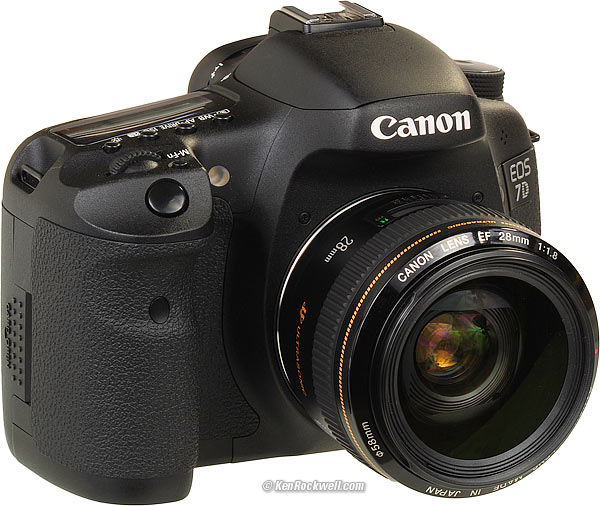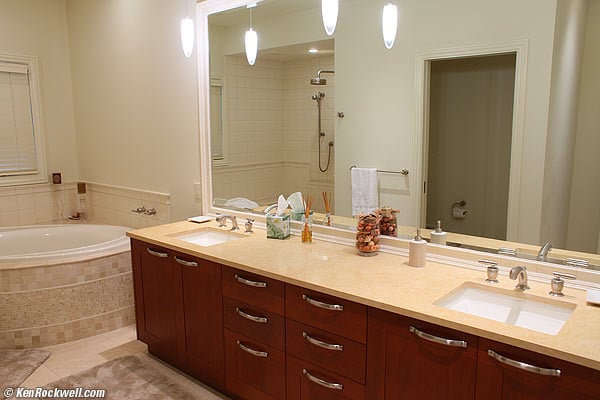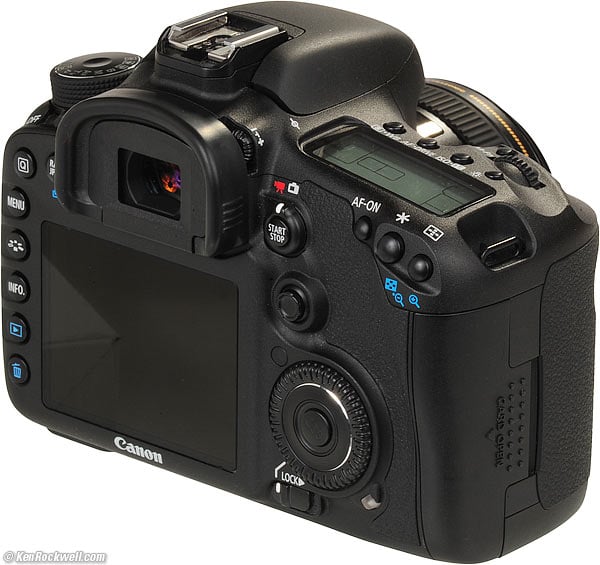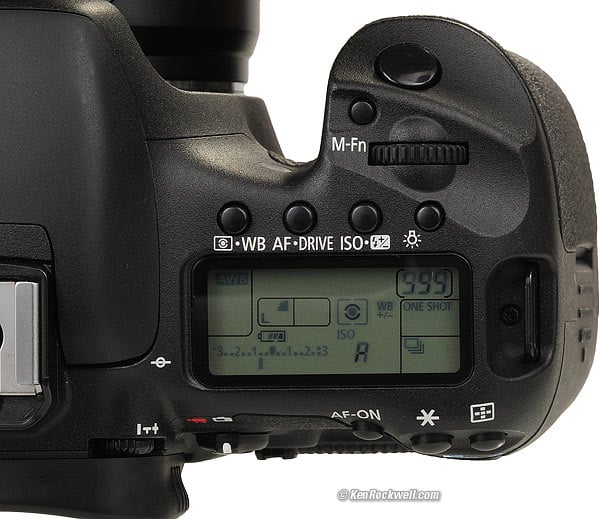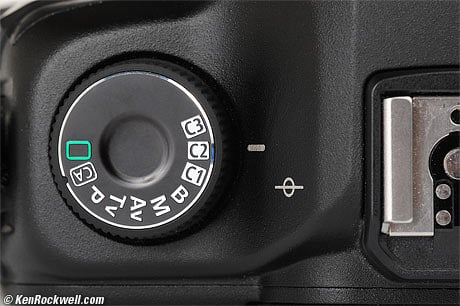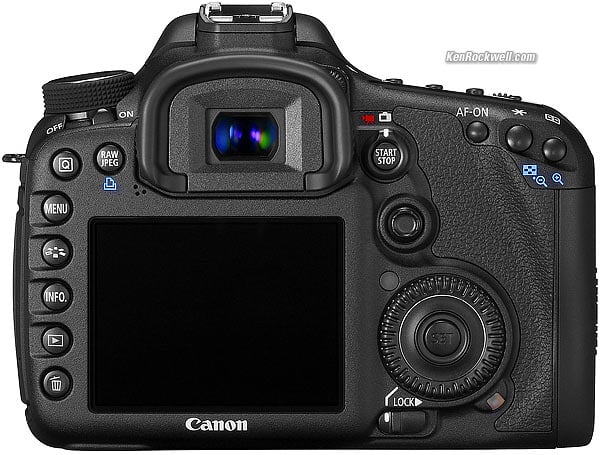Home Donate New Search Gallery How-To Books Links Workshops About Contact
Canon
7D Users Guide
© 2010 KenRockwell.com. All rights reserved.
Canon 7D with Canon 28mm f/1.8 USM. enlarge.
August 2010 Canon 7D Review More Canon Reviews
|
Adorama pays top dollar for your used gear. I use these stores. I can't vouch for ads below. |
Introduction top
This is a collection of my tips and tricks for how I use the Canon 7D.
This is how I set the 7D for my kind of pictures. I'm covering just what's important for making pictures, not every possible crazy setting.
Set the LCD brightness top
I set the LCD brightness to AUTO, and then to brighter, and it's always perfect.
To do this, press:
MENU > WRENCH •• > LCD Brightness > SET > AUTO (set with top dial) and MAX (set with rear dial) > SET.
Image Settings top
White Balance
I usually shoot in Auto White Balance (AWB), but trim the colors to add 5 steps of amber (A5).
To set white balance, use the Quick Control Screen > use rear thumb button to go to the AWB or other WB icon > SET > turn rear dial.
The 7D makes sunset colors, and things lit by sunset light, stay very yellow. If it's too yellow for you, set the WB SHIFT/BKT back to neutral from my personal default of A5.
Often AWB will make indoor scenes look way too orange. If so, try TUNGSTEN (the light bulb icon), or try the K white balance setting, setting it to about 2600K with the top dial. (Quick Control Screen > use rear thumb button to go to the AWB icon > SET > turn rear dial to K > turn top dial to 2600K.
You may use the K setting for anything. low numbers, like 2500K or 3000K, make things look cooler (bluer), and high numbers, like 7000K or 9000K make things look much warmer (more orange).
There is no "right" setting: use whatever looks best to you.
Your WB SHIFT/BKT settings apply in addition to whatever you've set as white balance, so you can make things warmer or cooler by adjusting either the K or WB settings as well as the WB SHIFT/BKT setting.
Color Saturation (Picture Styles)
For people, I shoot in the STANDARD [ *S ] Picture Style setting (you get there by hitting the rear top left "*" button), and change only the saturation to +2.
For everything else scenic or product, I usually set +3 saturation.
ISO
I usually shoot in AUTO ISO. It's one down from ISO 100.
If shooting action in the dark, since Auto ISO usually lets the camera drop to too slow a shutter speed (1/3 of a stop slower than 1/focal length), I'll dial-in ISO 1,600 or whatever I need to keep the speeds as I need them.
For example, with a 50mm lens, Auto ISO lets the shutter speed drop to 1/40, but with wiggly kids, I need 1/125.
Auto ISO forces ISO 400 with flash, but I usually prefer something slower and will set it deliberately if I have time.
Tweaks
I always leave the shadow optimizer (Automatic Lighting Optimizer) ON, which is its default.
I don't use highlight recovery (Highlight Tone Priority), since if I activate it, shadow optimization turns itself off.
Exposure Compensation
Exposure Compensation makes the pictures lighter or darker. You set it by turning the big rear dial; be sure the rear LOCK > slide switch isn't set to lock.
Colorful subjects in interesting outdoor light at +3 saturation can overload saturated highlights, so usually shoot at -2/3 compensation for scenic shots.
For most people or indoor photos, I leave compensation at 0.
If the subject is light and there are large areas of darkness, often the 7D's meter will aim for the darker sections, and I may need to dial-in -1 stop or more compensation.
No big deal; look at your LCD and use what looks best. Experience with your types of subjects will let you predict the best compensation without needing the LCD.
Exposure Lock top
The 7D locks the exposure by default as you half-press the shutter.
You also can lock it with the * button on the rear top right.
To unlock once you press the * button, move the top dial to a different setting and back. Pressing * again locks another value.
Color Trims top
It's easy to set precise green-magenta or amber-blue color adjustments.
Simply press:
MENU > CAMERA •• > WB SHIFT/BKT > SET > move the dot as you like with the thumb button > SET.
This setting applies to every white balance position, even AUTO and Kelvin.
For instance, here's a shot at my default WB setting of AUTO with A5 trim:
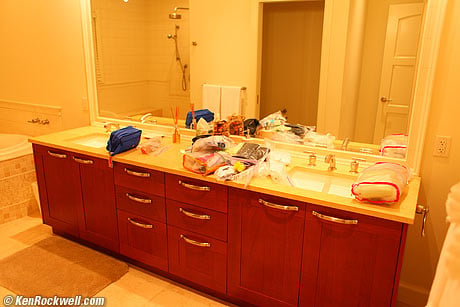
Too orange!
I then made another shot at 2,500K WB, which wasn't orange, but was too green.
I tried a few other settings, and quickly settled on A5 (amber) and M5 (magenta) WB SHIFT, easily tweaked by looking at the LCD as I changed settings for each shot. The LEICA M9 can't do this!
Maui Bathroom: Mixed CFL and halogen lighting, 2,500K A5 M5 WB. bigger.
File Formats
I shoot at LARGE JPG, and set it to NORMAL (the stair-step icon) instead of Canon's default of LARGE (quarter-circle icon as shown below).
Canon defaults to the FINE (quarter circle icon) setting, so I always set the NORMAL options deliberately.
Try it yourself: I've never seen any difference between NORMAL and FINE, and I do notice the smaller file sizes which transfer faster and take up much less space in my computer.
Image Size
No one really needs 18MP. All it does is slow everything and clog your hard drive, unless you're printing 10 feet wide.
Try shooting your 7D at its M (8MP) or S (4.5MP) settings. If you look at your images at 100%, you'll see that the lower resolution shots are sharper pixel-by-pixel!
When I'm photographing family and friends, I shoot at SMALL JPG. Even SMALL is good enough for great 20x30" prints.
The smaller-sized images out of the 7D are spectacular. They are sharper and cleaner than images from cameras on which that is their native resolution. The 7D always starts with 18MP, so it looks pretty good when you set the 7D to record at only 8MP or 4.5MP.
Why? Because they use less, or no, Bayer interpolation. No digital camera really resolves its rated resolution; they cheat and interpolate up, so at 100% at its rated resolution, no digital camera image is as sharp as a true scan from film.
At the 4.5MP setting, you have 100% R, G and B pixels, exactly as if you were using a Sigma Foveon sensor. If Sigma was selling this, they'd sell the 4.5MP (S) setting as if it were 13.5MP (also a lie).
What this means is that the lower resolution settings actually pack away lot more detail than you think. The S (4.5MP) setting of the 7D is a lot sharper than any 4.5MP camera.
M looks almost as good as L for the same reason.
If you're testing lenses, sure, shoot at L, but for everything else, try the settings for yourself, You'll probably get what you need at the smaller settings. For instance, the 11MP setting of the 7D has way more detail than any of the 12MP (native) Nikon cameras.
The resolution advantage of the 7D is obvious, even at lower settings. Try them.
I use LARGE for my scenic shots that I might print ten feet wide some day, but my family photos at 4.5MP, which is more than enough.
Flash
Flash exposure is often too light on the 7D. Look at your image, and often you'll need to use negative exposure compensation.
Unfortunately, flash exposure often varies from shot-to-shot, making it difficult to get perfect results every time. I see this both with the built-in flash as well as an external flash like my 220EX.
For fill-flash, try taping a piece of 1/4 CTO gel over an external flash for better people colors.
The built-in flash works great, but often can't recharge itself fast enough. You'll see BUSY in the finder for the ten seconds or so it's recharging. If you need to shoot more quickly, any external flash will recharge much faster.
Autofocus
Modes
You have three choices for how the 7D focuses using the sensors you're selected. (I cover AF point selection a little later).
These are the three modes, which are the same among all Canon EOS cameras since the 1980s:
ONE SHOT
Use this for still subjects. The camera focuses, and locks as soon as it gets focus. You then may recompose.
Use this, and wait for AF to lock, before you grab the focus ring with a lens with manual-focus override. Otherwise, the 7D will keep trying to pull focus control away from you.
AI SERVO
The camera keeps trying to focus as things move around. It never stops; it always tracks your subject in and out.
Don't use this setting if you want to use instant manual-focus override by grabbing your lens' focus ring: the 7D will keep trying to focus under you.
AI FOCUS
I use this most of the time. This clever setting usually selects whichever of the two settings above is appropriate, and uses it.
This setting cleverly locks itself when the subject is still, and tracks it when it's moving.
I only select ONE SHOT when I know I'm shooting stills, otherwise, for kids or whatever pops up, AI FOCUS is my choice.
You can use manual-focus override in AI FOCUS, but only if it has locked, which it rarely does. In most cases, the 7D will keep trying to focus in AI FOCUS unless you're on a tripod.
I usually shoot in the default of AUTO SELECT 19 POINTS. In this mode, the 7D just figures it out. It usually selects whatever's closest, so if your subject isn't the closest thing, you may need to select different AF points
Auto select usually works fine, but if it doesn't automatically select the correct points for me, I'll point the camera in a different way so that it might catch what I want. I'll hold the shutter to hold the focus, recompose, and shoot.
If this doesn't work, I'll use just one point and place it where I want it.
Canon 7D. enlarge.
To select one sensor, you have to select MANUAL SELECT: SINGLE POINT. You can do this either the slow way:
Quick Control Screen > use rear thumb button to go to the AF mode selection area, (on the left of the third row), and turn the rear dial.
That's swell, but you have to take the camera away from your eye. A faster, but more complex, way to do this with the 7D at your eye is to:
Press the rear top right [ + ] button (you'll see "[ ] AF" in the finder), then press the top M-Fn button (near the shutter), and now you can use either both dials or the rear thumb switch to select an AF point.
Once selected, the 7D only focuses on that area.
The center sensor is more sensitive than the others in dim light, and more precise with lenses of f/2.8 and faster. If the other sensors aren't doing well in dim light or aren't giving you sharp results, try the center sensor.
The Quick Control Screen top
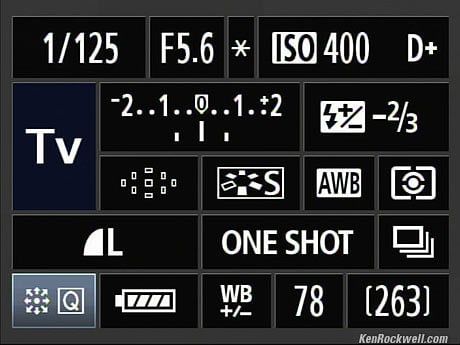
Canon 7D Quick Control Screen (actually from the 5D Mk II, but you get the idea).
You can control everything from one tap of the SET button, if you activate this feature by pressing:
MENU > CAMERA••••• (C.Fn) > C.Fn IV: Operation/Others > SET > 1: Custom Controls > SET > turn rear dial to highlight the SET button > SET > turn rear dial to select the [ Q ] (Quick Control Screen icon) > SET.
Now when you tap SET, it wakes up a control screen on the rear LCD from which we can control everything with the dial, joystick and SET button.
Once you get this screen, use the thumb button to drive around, and the dial to change the setting. If you need more details about what you're setting, press the SET button again, but it's not necessary.
There's no need to press OK or DONE or EXIT. The instant you've changed something, it's done.
I do wish I could drive off one end of the screen and arrive at the other side, but it stops at the ends.
You also can read and set apertures and shutter speeds on this screen, but in manual exposure mode, there is no indication for the correct exposure. For manual exposure, look at the bar graph in the finder or on the old top LCD.
If you tap the INFO button a couple of times, you'll call up the very similar INFO screen, which does drive the bar graph to let you set read manual exposure.
INFO Screen top
I didn't have a graphic for the Quick Control Screen, so the screen shown above is more precisely the INFO screen you'll get if you press INFO a couple of times.
They are the same, except that the bottom bar shows details on what you're setting if you're in the Quick Control screen.
If you call up this screen with the INFO button, it doesn't go away. To make this INFO screen go away, you have to press INFO again.
INFO Button
Tap this if you're not playing back, and it shows all sorts of goodies about how your 7D is set, the time and date, and how many shots and how much free space is left on your card.
Tap it again and a two-dimensional level appears.
Tap it a third time and the screen I showed above pops up, and won't go away until you press INFO again.
Electronic Level
Want an electronic level to help keep horizons and buildings straight?
Tap INFO twice, and it appears on the rear LCD!
I also set my M-Fn button to make it appear in the viewfinder. You can set this as described next.
Making the Controls Do Anything You Want top
Top, Canon 7D. You'll never use any of this except the M-Fn button. enlarge.
You can change the function of many of the controls, if you want to.
To screw with this, press :
MENU > CAMERA••••• (C.Fn) > C.Fn IV: Operation/Others > SET > 1: Custom Controls > SET > turn rear dial to highlight the control you wish to tweak > SET > turn rear dial to select your preference > SET.
Total Recall Camera State Memories top
C1, C2 and C3 Total Recall positions. bigger.
Set these before you go out, and everything you'll need will be right at your fingertips all day, or forever.
Each time you turn the dial to one of the C1, C1 or C3 positions, everything is reset to what was stored in that position.
Feel free to change any settings as you shoot in the C1, C2 or C3 positions. You won't erase what you saved. These changes will stay until the camera times-out, usually one minute (you can change that duration in the menus), and the next time you go to shoot, even if you had changed something, you're back at your saved settings.
If you want to return to the saved settings more quickly, just move the dial to any other position and return.
To Save a Suite of Settings
To save a complete camera-state setting of your 7D:
1.) Set the camera as you like. Everything is saved.
2.) Press:
MENU > WRENCH ••• > Camera user setting > SET > Register > choose the C1, C2 or C3 position > OK > SET.
To Make a Permanent Change to a Stored Setting
To change a stored setting:
1.) Set the dial to that setting, C1, C2 or C3. This recalls the setting.
2.) Change something.
3.) Save the camera's current state back into that dial position:
MENU > WRENCH ••• > Camera user setting > SET > Register > Carefully select the correct C1, C2 or C3 position > OK > SET.
If you select the wrong C1, C2 or C3, you will have overwritten the settings at that position — oops! — so be careful.
To Make a Temporary Change to a Stored Setting
Just change something as you would anywhere else.
As soon as you select or re-select a C setting, or as soon as the camera goes to sleep and wakes up again, your originally saved C setting is recalled.
The C settings themselves are not altered unless you deliberately save something into them as described above.
To Make a Longer Change to a Stored Setting
The 7D system allows all sorts of ways to make things easier.
As we just learned, if you change something in a C mode, after the camera resets in usually about a minute, all your temporary settings are reset.
What if you want to keep using slightly different settings for a longer period of time?
Easy!
If you want to save your temporary settings for up to about a half-hour or so, while in a C setting, press:
MENU > WRENCH • > Auto Power Off > (select longer time period) > SET.
Now the 7D will work in your C mode in your new settings for that period of time after you make your last shot, and then after that time (30 minutes maximum), automatically reverts to whatever you saved in that C setting. (If you leave that C setting and return, it also resets instantly.)
Here's the clever part: you keep that setting for 30 minutes, and when the 7D resets to your saved C setting, the time-out period also reverts to whatever you saved before, probably one minute! Thus you can alter a C setting for a while, it won't change, and when you're done, Voilà!, the 7D gets you back to where you wanted to be automatically!
To Make a Longer Change to a Stored Setting
Let's not forget the usual P, Tv, Av and M positions.
When you change one of them, they stay that way forever.
The four of them together are sort of like an unlocked C setting: every time you come back to them, they are as you left them, but if you change something while there, they stay that way.
If dealing with some weird light that requires odd White Balance settings, you may want to use the P, Tv, Av or M positions, and then if a different opportunity presents itself, flip into one of your C modes, and as soon as you click back into any of P, Tv, Av or M positions, you're where you left off.
Brilliant!
My personal Total Recall settings
C1 |
C2 |
C3 |
|
| Used for | Scenic |
Family |
Daylight Action |
| Exposure Mode | Pro (P) |
Pro (P) |
Av at f/5.6 |
| Resolution | L (5,184) |
S (2,560) |
M (3,456) |
| Picture Style | +3 Saturation |
+2 Saturation |
+2 Saturation |
| Exposure Comp. | -2/3 |
0 |
0 |
| AF | One Shot |
AI Focus |
AI Servo |
| AF Sensors | Auto (all) |
Auto (all) |
Just one |
| Advance | Continuous (3fps) |
Continuous (3fps) |
High (8fps) |
| ISO | Auto |
Auto |
ISO 400 |
| Movie Resolution | 1920/23.98p* |
640/59.94p* |
720/59.94p* |
* read as 24p and 60p in the menu system.
Long Exposures top
The rear red pilot light stays on during long exposures.
I'd skip Long Exposure NR; I get great results without it.
Live View top
Canon 7D. enlarge.
I don't use this.
To get it to go, just press the rear START STOP button, with the switch set to the silver camera icon.
Video top
Video is easy to shoot.
Flick the switch around the START STOP button to the red movie camera icon, and press it to start and stop.
Press the AF-ON button before shooting to focus. You may press AF-ON while rolling, but if you do, you'll probably hear the noise in audio recorded by the camera's built-in microphone, and the video will show the lens racking in and out looking for focus.
You only can set the movie options for resolution and frame rate while the switch is set to movies. When you slide that switch, you'll find the movie shooting options in the fourth red menu option, which changes its name and icon from the CAMERA•••• menu seen in normal shooting with the rear rotating START STOP switch set to the silver camera icon.
The Total Recall settings are total recall settings: I use them to recall different shooting resolutions and color settings instantly!
My Menu Menu top
It's easy to put whatever you need in the last green star menu. (Press MENU > click right to the green star.)
I put these in mine:
1.) Select Folder (used to make a new folder each day)
2.) Battery Info
To add and edit items, simply use the My Menu settings option (MENU > My Menu > My Menu settings).
Folders top
It's easy to make new folders. I put this item in the MY MENU menu.
Each time you make a new folder, it's number increments by one. You can't name them.
It's easy to use this menu to see what folders you have, and what's in them.
I make a new folder each day. Sadly, unlike Canon's point-and-shoots, there is no option for having new, dated, folders automatically created for you each day. Again, the Powershot and EOS teams need to have sake together more often.
AF Microadjustment top
Don't touch this.
If you have to ask how to set it, then you'll probably make it worse if you fiddle with it.
If you insist on playing with it, know that only about one lens in twenty needs any adjustment, and the results are only visible at large apertures.
If you use zoom lenses, be forewarned that there is only one setting available per lens, and that zooms may need different settings for each focal length.
When you do set it, the 7D is smart enough to recall different settings for different lenses as you set them, automatically.
When setting it, use natural targets like trees. Don't use tilted flat targets, since the actual location of the AF sensors is never really exactly where they are marked in the finder.
To set it, you need to make many, many test shots to arrive at a setting. Every shot varies a little from shot to shot; no AF system gives the same result for each shot. Make at least 5 shots at every distance, and try every distance, since the settings can vary by distance.
To screw with this, press:
MENU > CAMERA••••• (C.Fn) > C.Fn III: Autofocus/Drive > SET > 5: AF Microadjustment > SET and have at it.
Help me help you top
I support my growing family through this website, as crazy as it might seem.
If you find this as helpful as a book you might have had to buy or a workshop you may have had to take, feel free to help me continue helping everyone.
If you've gotten your gear through one of my links or helped otherwise, you're family. It's great people like you who allow me to keep adding to this site full-time. Thanks!
If you haven't helped yet, please do, and consider helping me with a gift of $5.00.
The biggest help is to use these links to Adorama, Amazon, B&H, Calumet, Ritz and J&R when you get your goodies. It costs you nothing and is a huge help. These places have the best prices and service, which is why I've used them since before this website existed. I recommend them all personally.
This page is copyrighted and registered, so if you'd like to make a printout for personal use and haven't helped me otherwise, you must PayPal me $5.00 for each copy as a license (your PayPal confirmation is your receipt), just as you'd pay for any other printed guide or eBook. I find it much easier to let you read this first and pay on your own, than trying to ask for payment first.
If you got your 7D through my links, thank you, and please enjoy printing this page for yourself with my compliments.
Thanks for reading!
Ken
Home Donate New Search Gallery How-To Books Links Workshops About Contact

